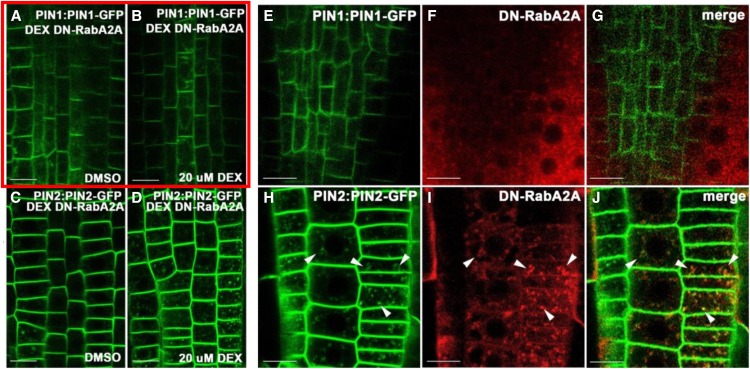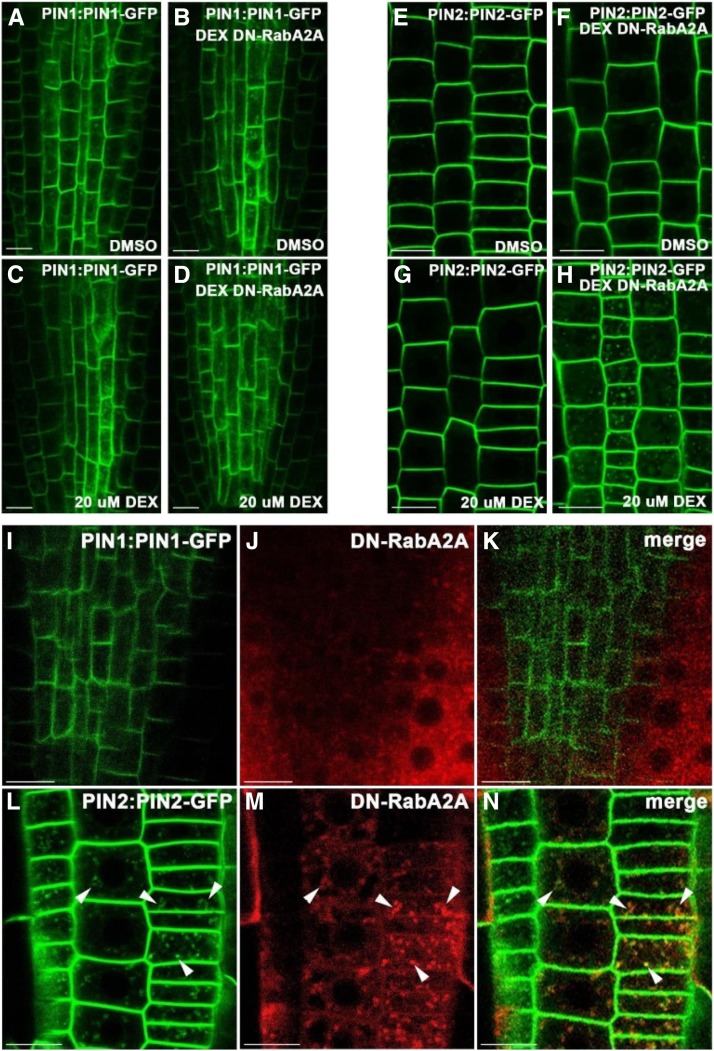Li, R., Furlan, C.R., Wang, J., van de Ven, W., Gao, T., Raikhel, N.V., and Hicks, G.R. (2017). Different endomembrane trafficking pathways establish apical and basal polarities. Plant Cell 29: 90–108.
The authors of the above article request the publication of corrected Supplemental Figure 6, as described below. The original results and conclusions are unaffected by the corrections.
In the original publication, Figures 1D and 1E were duplicated in Supplemental Figures 6A and 6B, respectively. Upon examining original data generated by lead author Dr. Li, Figures 1D and 1E were found to be correct as published but were incorrectly duplicated in Supplemental Figure 6.
The original data that should have been included in Supplemental Figure 6 were reexamined and independently reproduced in two labs (Dr. Li and Drs. Hicks/Raikhel). This included independently reproducing crosses of a line expressing PIN1:PIN1-GFP with a line expressing DN-RabA2A to produce PIN1:PIN1-GFP DEX DN-RabA2A. The new experiments were conducted by Dr. Lei Pang, a postdoc in Dr. Li’s lab and Dr. Cecilia Rodriquez-Furlan, a postdoc in the lab of Drs. Hicks/Raikhel. Coauthor Dr. Rodriguez-Furlan was not involved in data generated for Figure 1 or Supplemental Figure 6 in the original publication. The lead author of the original publication, Dr. Li, did not participate in the new experiments. Dr. Li did not inform Dr. Lei Pang about the purpose of the experiments, so the experiments were performed as a blind test.
Additional controls are included in the corrected Supplemental Figure 6A. Supplemental Figures 6A [PIN1:PIN1-GFP (DMSO)], 6C [PIN1:PIN1-GFP (20uM DEX)], 6E [PIN2:PIN2-GFP (DMSO)], and 6G [PIN2:PIN2-GFP (20 μM DEX) indicate that PIN1 and PIN2 localization in the presence of DEX is unaffected. The results from both labs support the published conclusion that overexpression of DN-RabA2A induces aggregates of PIN2 but not PIN1.
The original manuscript included the following discussion of Supplemental Figure 6. “Indeed, a dexamethasone (DEX)-inducible dominant-negative mutation of RabA2A (S26N) induced ES16-like bodies of PIN2 but not PIN1 (Supplemental Figures 6A to 6D). Stable transgenic lines overexpression of DN-RabA2A also increased PIN2 but not PIN1 internalization, which colocalized with the DN-RabA2A vesicles (Supplemental Figures 6E to 6J), similar to ES16.”
To reflect the corrected Supplemental Figure 6, these lines should be replaced by the following. “Indeed, a dexamethasone (DEX)-inducible dominant-negative mutation of RabA2A (S26N) induced ES16-like bodies of PIN2 but not PIN1 (Supplemental Figures 6A to 6H). Stable transgenic line overexpression of DN-RabA2A also increased PIN2 but not PIN1 internalization, which colocalized with the DN-RabA2A vesicles (Supplemental Figures 6I to 6N), similar to ES16.”
The original and corrected versions of Supplemental Figure 6 are shown below; the original figure is marked with red boxes and text in bold below the legend indicating the incorrect panels. The article (xml and pdf) and supplemental file were resupplied on August 13, 2018.
All authors approve of this correction, with the exception of Ting Gao, who could not be reached.
Supplemental Figure 6.
Original: Overexpression of DN-RabA2A Induces Aggregates of PIN2 but Not PIN1.
(A) and (B) The 20 µM DEX-induced overexpression of DN-RabA2A does not change the PIN1 protein localization.
(C) and (D) The 20 µM DEX-induced overexpression of DN-RabA2A significantly increases PIN2 internalization, as visualized by the intracellular vesicles.
(E) to (G) Stable overexpression of DN-RabA2A does not change the PIN1 polarity.
(H) to (J) Stable overexpression of DN-RabA2A results in enhanced PIN2 agglomerations, which are colocalized with the DN-RabA2A vesicles (white arrowheads). Images are representative of three repeats. Bars = 10 µm. Note: (A) and (B) (boxed in red) were incorrectly duplicated from Figures 1D and 1E, respectively, of the main manuscript, and the labels are incorrect in the above supplemental figure.
Supplemental Figure 6.
Corrected: Overexpression of DN-RabA2A Induces Aggregates of PIN2 but Not PIN1.
(A) and (C) The 20 µM DEX induction does not change the PIN1 protein localization.
(B) and (D) The 20 µM DEX-induced overexpression of DN-RabA2A does not change the PIN1 protein localization.
(E) and (G) The 20 µM DEX induction does not change the PIN2 protein localization.
(F) and (H) The 20 µM DEX-induced overexpression of DN-RabA2A significantly increases PIN2 internalization as visualized by intracellular vesicles.
(I) to (K) Stable overexpression of DN-RabA2A does not change PIN1 polarity.
(L) to (N) Stable overexpression of DN-RabA2A results in enhanced PIN2 agglomerations, which are colocalized with the DN-RabA2A vesicles (white arrowheads). Images are representative of three repeats. Bars = 10 µm. Note: Original panels (E) to (J) are relabeled (I) to (N).
Footnotes
Articles can be viewed without a subscription.
Editor’s note: This correction was reviewed by members of The Plant Cell editorial board.




